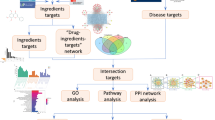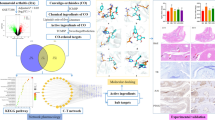Abstract
Introduction
Qin Xi Tong (QXT), produced by water extracts of Caulis Sinomenii, is clinically effective in the therapy of rheumatoid arthritis (RA). It is also a complementary agent for osteoarthritis (OA). This study aimed to screen the candidate targets and identify the potential mechanisms of QXT against RA and OA.
Method
The active ingredients contained in QXT were queried from the TCMSP database. Their predicted targets were obtained through web-based databases, including TCMSP, BATMAN-TCM, CTD, and PharmMapper. The OA and RA targets were collected from the Genecards database and the GSE55235 dataset. Based on the DAVID database, GO and KEGG enrichment analyses of disease-drug common targets predicted potential signaling pathways for QXT. In addition, core targets were identified by mapping component-target-disease interaction networks with Cytoscape 3.9.1 and STRING. The Swissdock and Pymol tools further validate the predicted results.
Results
A total of 161 genes were put forward as potential targets for treating RA and OA. These genes might be involved in joint inflammation, including the IL-17 signaling pathway, MAPK signaling pathway, and TNF signaling pathway. They also regulated the progression of joint injuries, such as apoptosis, Th17 cell differentiation, and osteoclast differentiation. In addition, we identified 12 core targets of QXT. Molecular docking results showed that QXT has a high affinity with these core targets.
Conclusions
This study reveals the mechanism governing the effect of QXT on RA and OA, predicts the direct target, and provides new ideas for clinical treatment.
Key Points • Our study reveals the underlying mechanism of QXT in the treatment of RA and OA. • Further research into the effects of compounds in QXT alone would be of interest. |






Similar content being viewed by others
Abbreviations
- QXT:
-
Qing-Xi-Tong
- OA:
-
osteoarthritis
- RA:
-
rheumatoid arthritis
- TCMSP:
-
traditional Chinese medicine systems pharmacology database and analysis platform
- OB:
-
oral availability
- DL:
-
drug-like properties
- GEO:
-
Gene Expression Omnibus
- DEG:
-
differentially expressed genes
- PPI:
-
protein-protein interaction
- MCODE:
-
molecular complex detection
- GO:
-
gene ontology
- KEGG:
-
Kyoto Encyclopedia of Genes and Genomes
- DAVID:
-
database for annotation, visualization, and integrated discovery
- BC:
-
betweenness
- CC:
-
closeness
- DC:
-
degree
References
Safiri S, Kolahi AA, Cross M, Carson-Chahhoud K, Almasi-Hashiani A, Kaufman J, Mansournia MA, Sepidarkish M, Ashrafi-Asgarabad A, Hoy D, Collins G, Woolf AD, March L, Smith E (2021) Global, regional, and national burden of other musculoskeletal disorders 1990-2017: results from the global burden of disease study 2017. Rheumatology (Oxford) 60(2):855–865. https://doi.org/10.1093/rheumatology/keaa315
Jones IA, Togashi R, Wilson ML et al (2019) Intra-articular treatment options for knee osteoarthritis. Nat Rev Rheumatol 15:77–90
Frangos T, Maret W (2020) Zinc and cadmium in the aetiology and pathogenesis of osteoarthritis and rheumatoid arthritis. Nutrients 13:53
Vamathevan J, Clark D, Czodrowski P et al (2019) Applications of machine learning in drug discovery and development. Nat Rev Drug Discov 18:463–477
Fagundes Rosales P, Gower A, Lucia Ruiz Benitez M et al (2019) Extraction, isolation and in vitro evaluation of affinisine from tabernaemontana catharinensis in human melanoma cells. Bioorg Chem 90:103079
Zheng K, Chen Z, Sun W et al (2018) Hei-gu-teng zhuifenghuoluo granule modulates il-12 signal pathway to inhibit the inflammatory response in rheumatoid arthritis. J Immunol Res 2018:8474867
Camponogara C, Casoti R, Brusco I et al (2019) Tabernaemontana catharinensis leaves effectively reduce the irritant contact dermatitis by glucocorticoid receptor-dependent pathway in mice. Biomed Pharmacother 109:646–657
Mohammadi A, Mansoori B, Baradaran B (2017) Regulation of mirnas by herbal medicine: an emerging field in cancer therapies. Biomed Pharmacother 86:262–270
Liu JY, Liu D, Chen Q et al (2014) Clinical research for the effectiveness and economic value of qinxitong in the patients with ra in china. Value Health 17:A775
Zhang W, Tao Q, Guo Z et al (2016) Systems pharmacology dissection of the integrated treatment for cardiovascular and gastrointestinal disorders by traditional chinese medicine. Sci Rep 6:32400
Szklarczyk D, Franceschini A, Kuhn M et al (2011) The string database in 2011: Functional interaction networks of proteins, globally integrated and scored. Nucleic Acids Res 39:D561–D568
Nomura S, Satoh M, Fujita T et al (2018) Cardiomyocyte gene programs encoding morphological and functional signatures in cardiac hypertrophy and failure. Nat Commun 9:4435–4435
Tang Y, Li M, Wang J et al (2015) Cytonca: a cytoscape plugin for centrality analysis and evaluation of protein interaction networks. Biosystems 127:67–72
Bitencourt-Ferreira G, de Azevedo WF (2019) Docking with swissdock. Methods Mol Biol 2053:189–202
Khan NM, Clifton KB, Lorenzo J et al (2020) Comparative transcriptomic analysis identifies distinct molecular signatures and regulatory networks of chondroclasts and osteoclasts. Arthritis Res Ther 22:168–168
Li C, Du X, Liu Y et al (2020) A systems pharmacology approach for identifying the multiple mechanisms of action for the rougui-fuzi herb pair in the treatment of cardiocerebral vascular diseases. Evid Based Complement Alternat Med 2020:5196302
Nogales C, Mamdouh ZM, List M et al (2022) Network pharmacology: curing causal mechanisms instead of treating symptoms. Trends Pharmacol Sci 43:136–150
Zhang F, Liu Z, He X et al (2020) Β-sitosterol-loaded solid lipid nanoparticles ameliorate complete freund’s adjuvant-induced arthritis in rats: involvement of nf-кb and ho-1/nrf-2 pathway. Drug Deliv 27:1329–1341
Lan Z, Wei M, Chen L et al (2016) Role of sinomenine on complete Freund’s adjuvant-induced arthritis in rats. IUBMB Life 68:429–435
Feng Z-T, Yang T, Hou X-Q et al (2019) Sinomenine mitigates collagen-induced arthritis mice by inhibiting angiogenesis. Biomed Pharmacother 113:108759
Tyagi AM, Srivastava K, Mansoori MN et al (2012) Estrogen deficiency induces the differentiation of il-17 secreting th17 cells: a new candidate in the pathogenesis of osteoporosis. PLoS One 7:e44552
Wei Y, Luo L, Gui T et al (2021) Targeting cartilage egfr pathway for osteoarthritis treatment. Sci Transl Med 2021:13
Yalçın Kehribar D, Özgen M, Yolbaş S et al (2021) The inhibition of src kinase suppresses the production of matrix metalloproteinases in from synovial fibroblasts and inhibits Mapk and stats pathways. Turk J Med Sci 51:2142–2149
Yekkirala AS, Roberson DP, Bean BP et al (2017) Breaking barriers to novel analgesic drug development. Nat Rev Drug Discov 16:545–564
Ao L, Gao H, Jia L et al (2022) Matrine inhibits synovial angiogenesis in collagen-induced arthritis rats by regulating hif-vegf-ang and inhibiting the pi3k/akt signaling pathway. Mol Immunol 141:13–20
Malemud CJ (2019) Inhibition of mmps and adam/adamts. Biochem Pharmacol 165:33–40
Fan D, He X, Bian Y et al (2016) Triptolide modulates trem-1 signal pathway to inhibit the inflammatory response in rheumatoid arthritis. Int J Mol Sci 17:498
Yang M, Gu J, Xu F et al (2022) The protective role of glucocerebrosidase/ceramide in rheumatoid arthritis. Connect Tissue Res 63:625–633
Ramesova A, Svandova E, Vesela B et al (2022) Autophagy-related proteases accompany the transition of pre-chondrogenic cells into chondroblasts. Ann Anat 239:151781
Liang T, Chen T, Qiu J et al (2021) Inhibition of nuclear receptor rorα attenuates cartilage damage in osteoarthritis by modulating il-6/stat3 pathway. Cell Death Dis 12:886
Rösch G, Muschter D, Taheri S et al (2021) Β2-adrenoceptor deficiency results in increased calcified cartilage thickness and subchondral bone remodeling in murine experimental osteoarthritis. Front Immunol 12:801505
Grskovic I, Kutsch A, Frie C et al (2012) Depletion of annexin a5, annexin a6, and collagen x causes no gross changes in matrix vesicle-mediated mineralization, but lack of collagen x affects hematopoiesis and the th1/th2 response. J Bone Miner Res 27:2399–2412
Scotece M, Koskinen-Kolasa A, Pemmari A et al (2020) Novel adipokine associated with oa: Retinol binding protein 4 (rbp4) is produced by cartilage and is correlated with mmps in osteoarthritis patients. Inflamm Res 69:415–421
Lu X, Fan Y, Li M et al (2021) Htr2b and slc5a3 are specific markers in age-related osteoarthritis and involved in apoptosis and inflammation of osteoarthritis synovial cells. Front Mol Biosci 8:691602
Rowe MA, Harper LR, McNulty MA et al (2017) Reduced osteoarthritis severity in aged mice with deletion of macrophage migration inhibitory factor. Arthritis Rheumatol 69:352–361
Olesen AE, Nielsen LM, Feddersen S et al (2018) Association between genetic polymorphisms and pain sensitivity in patients with hip osteoarthritis. Pain Pract 18:587–596
Zhao J, Xu L, Chang C et al (2022) Circulating methylation level of htr2a is associated with inflammation and disease activity in rheumatoid arthritis. Front Immunol 13:1054451
Liu NJ, Chapman R, Lin Y et al (2016) Point of care testing of phospholipase a2 group iia for serological diagnosis of rheumatoid arthritis. Nanoscale 8:4482–4485
Mosquera N, Rodriguez-Trillo A, Mera-Varela A et al (2018) Uncovering cellular retinoic acid-binding protein 2 as a potential target for rheumatoid arthritis synovial hyperplasia. Sci Rep 8:8731
Erlandsson MC, Töyrä Silfverswärd S, Nadali M et al (2017) Igf-1r signalling contributes to il-6 production and t cell dependent inflammation in rheumatoid arthritis. Biochim Biophys Acta Mol Basis Dis 1863:2158–2170
Funding
This study was supported by grants from the Natural Science Basic Research Program of Shaanxi (No. 2023-JC-YB-765), Administration of Traditional Chinese Medicine of Shaanxi (No. SZY-KJCYC-2023-060), Traditional Chinese Medicine Research Projects of Xi’an (No. SZJ202102), Scientific Research Project of Xi’an Municipal Health Commission (No. 2021yb39).
Author information
Authors and Affiliations
Contributions
Yanyan Lv and Xiaoqiang Huang conceived and designed the research methods. Yanyan Lv, Jie Zhang, Chao Li, and Lei Lei collected and analyzed the data. Yanyan Lv wrote the original draft. Li Wang and Xiaoqiang Huang reviewed and edited the manuscript. All authors read and approved the final manuscript.
Corresponding author
Ethics declarations
Disclosures
None.
Additional information
Publisher’s note
Springer Nature remains neutral with regard to jurisdictional claims in published maps and institutional affiliations.
Supplementary information
ESM 2: The differentially expressed genes (DEGs) in the GSE55235 dataset.
Table S1 (XLSX 1765 kb)
ESM 3: The pathway enrichment analysis of the common targets of QXT and OA or QXT and RA.
Table S2 (XLSX 384 kb)
ESM 4: The pathway enrichment analysis of potential targets of QXT alleviating OA and RA.
Table S3 (XLSX 192 kb)
ESM 5: The pathway enrichment analysis of cluster1 and cluster2 containing targets.
Table S4 (XLSX 22 kb)
Rights and permissions
Springer Nature or its licensor (e.g. a society or other partner) holds exclusive rights to this article under a publishing agreement with the author(s) or other rightsholder(s); author self-archiving of the accepted manuscript version of this article is solely governed by the terms of such publishing agreement and applicable law.
About this article
Cite this article
Lv, Y., Zhang, J., Li, C. et al. Network pharmacological analysis to reveal the mechanism governing the effect of Qin Xi Tong on osteoarthritis and rheumatoid arthritis. Clin Rheumatol 42, 2209–2222 (2023). https://doi.org/10.1007/s10067-023-06625-5
Received:
Revised:
Accepted:
Published:
Issue Date:
DOI: https://doi.org/10.1007/s10067-023-06625-5




